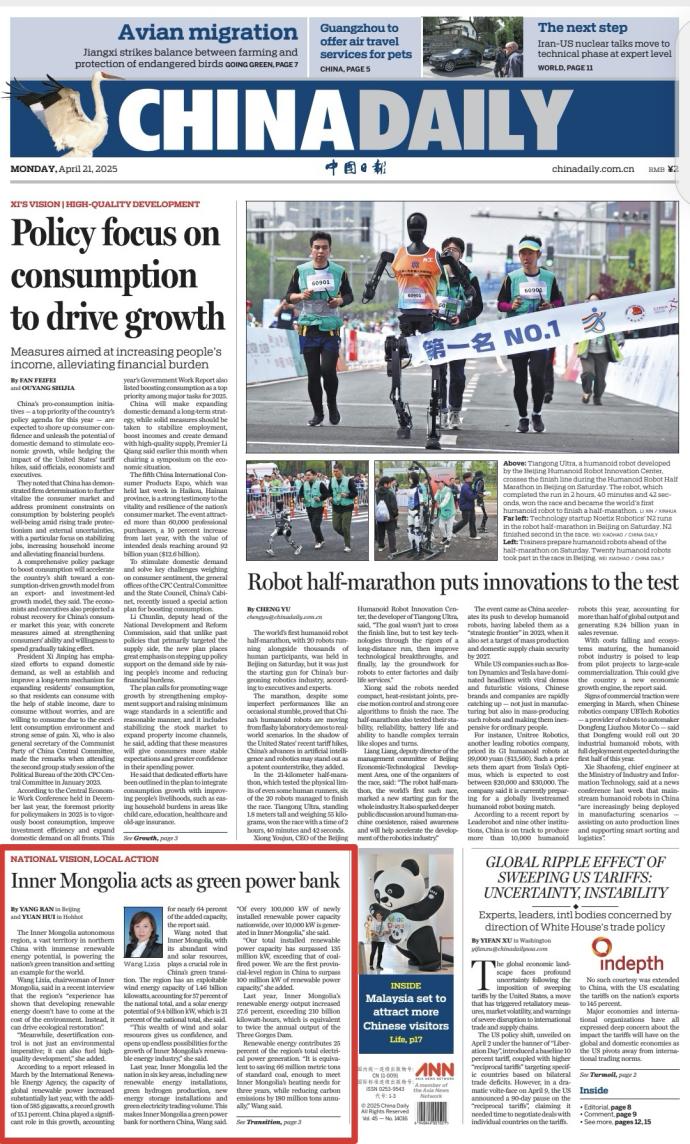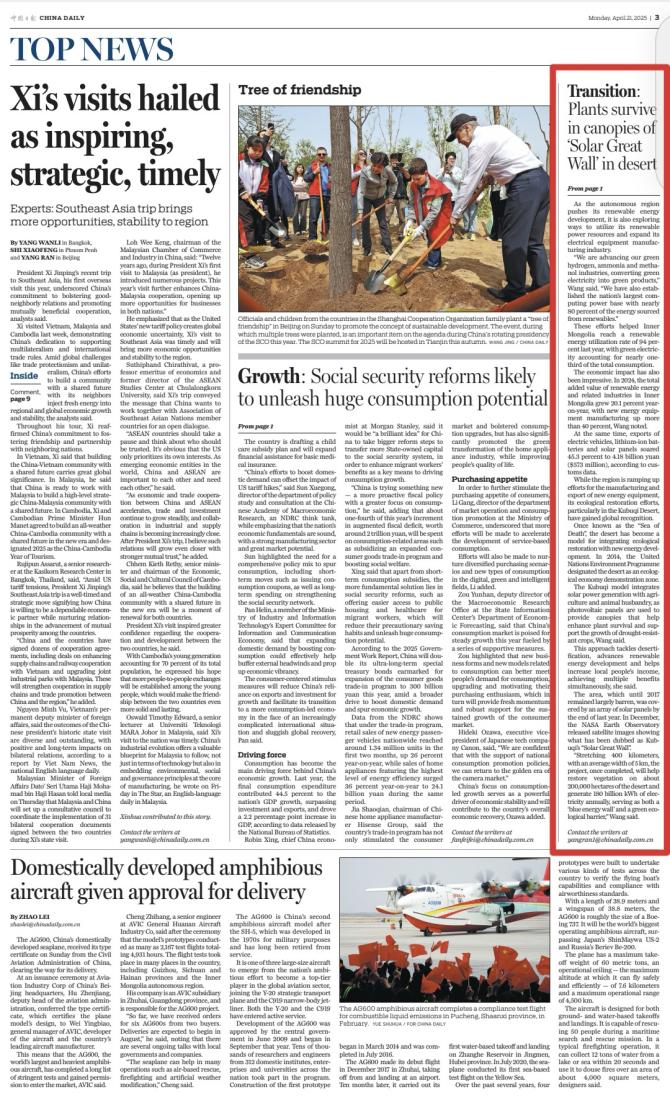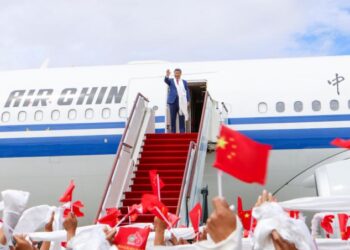Introduction:
In order to thoroughly publicize and implement Xi Jinping’s ecological civilization thought and Xi Jinping’s cultural thoughts, earnestly publicize and implement the spirit of the 20th National Congress of the Communist Party of China and the Second and Third Plenary Sessions of the 20th Central Committee of the Communist Party of China, and further talk about the practice of green, low-carbon and high-quality development to the international community, on April 21, the “Local Practice of Chinese-style Modernization” column on the front page of the “China Daily” published an exclusive interview with Wang Lixia, Deputy Secretary of the Party Committee of the Inner Mongolia Autonomous Region and Chairman of the People’s Government of the Autonomous Region, “Inner Mongolia accelerates the high-quality development of the new energy industry and strives to build an important national energy and strategic resource base).
Wang Lixia, Deputy Secretary of the Party Committee of Inner Mongolia Autonomous Region and Chairman of the People’s Government of the Autonomous Region
Reporter: What are the unique advantages of Inner Mongolia in developing new energy, and what new breakthroughs and highlights did it make last year?
Wang Lixia: When talking about Inner Mongolia, many friends think of herds of cattle and sheep, vast grasslands, and magnificent scenery. When General Secretary Xi Jinping visited Inner Mongolia in 2014, he quoted the song “Beautiful Grassland My Home” sung by Dedema to praise Inner Mongolia. The song “The wind blows green grass everywhere” and “Cows and sheep are like pearls scattering” are true portrayals of the beautiful scenery of Inner Mongolia. Today, Inner Mongolia is not only beautiful in natural scenery, but also in the “blue ocean” where windmills and photovoltaic panels dance with the wind, adding more charm to this beautiful landscape in the northern border of the motherland. When many people come to Inner Mongolia, they will be shocked by the “scenery” scenes that can be seen everywhere.
Inner Mongolia is one of the regions with the best scenic resources in my country and is a hot spot for new energy development. General Secretary Xi Jinping is deeply concerned about this land and has established the strategic positioning of “two barriers”, “two bases” and “one bridgehead”. One of them is to build an important national energy and strategic resource base, encouraging us to “a clear direction, a right path, a good prospect, great achievements and great prospects.” From the perspective of the “prospects” and “prospects” of new energy, I think it mainly comes from four aspects, which can be summarized as “4 good ones”.
First, good policies from the country. Inner Mongolia has successively approved the first, second, third batch of national large-scale wind power photovoltaic base projects and the “Shagohuang” large-scale wind power photovoltaic base projects. Since 2023, the State Council has issued the “Opinions on Promoting the High-Quality Development of Inner Mongolia and striving to Write a New Chapter of Chinese-style Modernization”, and the National Development and Reform Commission and six other departments have issued the “Notice on Several Policy Measures to Support Inner Mongolia’s Green, Low-Carbon and High-Quality Development” and other documents, providing strong support for the development of Inner Mongolia’s new energy industry.
The second is a good resource with unlimited scenery. Inner Mongolia is a “treasure house” of energy, which not only has “sheep coal and rustic atmosphere”, but also “chasing the wind and sun”. The development volume of wind energy resource technology is 1.46 billion kilowatts, accounting for about 57% of the country, and the development volume of solar energy resource technology is 9.4 billion kilowatts, accounting for about 21% of the country. The “unlimited scenery” foundation is not only our confidence, but also bringing unlimited possibilities to the development of the new energy industry.
Third, it is a good market adjacent to Beijing, Tianjin and Hebei. Inner Mongolia is connected to eight provinces and adjacent to Beijing-Tianjin-Hebei. Whether from Hohhot, the capital of the west, or from Chifeng in the east, the high-speed rail can reach Beijing in more than two hours, integrating into the “2-hour economic circle” of Beijing-Tianjin-Hebei. We make full use of this location advantage, focus on the “needs” of Beijing-Tianjin-Hebei and the “what can” of Inner Mongolia, and make every effort to ensure energy supply. In the first two months of this year, the green electricity transmitted to the capital through the ultra-high voltage power grid exceeded 1 billion kWh, equivalent to the annual electricity consumption of 300,000 households.
Fourth, a good foundation for peak-shaving delivery. Inner Mongolia not only has “the scenery above its head”, but also “there is coal under its feet” and “there is the power grid in its hands.” The proven reserves of coal resources are ranked first in the country, and the long-term reserves account for 1/4 of the country. Coupled with the huge thermal power units, it provides a foundation for new energy peak shaving. Inner Mongolia also has a relatively independent Mongolian-Western power grid, providing opportunities for new energy grid connection and exploration of the construction of new power systems.
In the practice of proactive action and innovative development, we have explored a unique new energy development model, allowing all kinds of advantages to be maximized, and achieved a series of milestone achievements. Last year, six national firsts were the total installed capacity of new energy, new installed capacity, power generation, green hydrogen production capacity, new energy storage installation capacity, and green electricity transaction scale. It is a well-deserved giant green “power bank” in the north of the motherland. Specifically:
First, the “capacity” is larger. Last year, the new installed capacity of new energy exceeded 41 million kilowatts. For every 100,000 kilowatts of new installed capacity nationwide, more than 100,000 kilowatts are in Inner Mongolia. Driven by the acceleration of new installed capacity, Inner Mongolia’s total installed capacity has exceeded 100 million in the country and reached 135 million kilowatts, exceeding the total installed capacity of thermal power, one year ahead of our proposed goal of “new energy installed capacity exceeds thermal power installed capacity in 2025”.
Second, the “power” is more sufficient. Last year, Inner Mongolia’s new energy power generation exceeded 210 billion kWh, an increase of 27.6%, which is equivalent to the annual power generation of the two Three Gorges projects. This 210 billion kWh accounted for about 25% of the total power generation in the region, which means that for every 4 kWh of electricity in Inner Mongolia, 1 kWh of green electricity is generated. The standard coal is equivalent to 66 million tons, which is equivalent to Inner Mongolia’s three years of heating coal, and is equivalent to reducing carbon emissions by 180 million tons per year.
Third, there is more “charging”. In order to light up the lights of thousands of homes with the scenery of the grassland, we have built 17 delivery channels, built the “four horizontal and five vertical” “money” in western Mongolia and “six horizontal and one vertical” 500 kV main grid in eastern Mongolia, with the power transmission capacity reaching 75 million kilowatts; we are also the first in the country to carry out cross-provincial ultra-high voltage green electricity transactions, and established green electricity export transaction cooperation with five provinces, with the transaction scale reaching 76.2 billion kW, with the leader’s “first one horse” and driving the “ten thousand horses galloping” of the national new energy development.
Reporter: What measures has Inner Mongolia taken to support the development of the new energy industry?
Wang Lixia: In the past, it was mainly driven by resource-driven, simply digging coal and digging soil to sell soil. This resource development model has reached the “ceiling”. In the development of the new energy industry, we will never “wear new shoes and follow the old path” or simply “generate and sell electricity”. Instead, we will focus on the consumption and utilization of new energy on the one hand and the development of new energy equipment manufacturing industry on the other hand, and take the new path of “grasping both hands”.
In terms of consumption and utilization, we will do our best to do the “second half” of new energy installation to prevent large-scale abandonment of wind and light. First, we must focus on consumption, and take the lead in the country to propose six types of new energy market-oriented consumption models, and innovatively introduce 23 policies and measures to promote the consumption of new energy. Last year, the utilization rate of new energy reached 94%, and green electricity consumption was close to 30% of electricity consumption. The second is to focus on transformation. We actively deployed the green hydrogen ammonia alcohol industry and extended the green electricity generation to green hydrogen, green ammonia, and green alcohol, achieving “one electricity to three greens”. Last year, the green hydrogen production capacity reached 60,000 tons, ranking first in the country. The third is to focus on energy storage, implement new energy storage demonstration projects, and carry out special actions to develop new energy storage. Last year, the scale of new energy storage installed capacity was 7.08 million kilowatts, an increase of 2.4 times, and the total scale exceeded 10 million kilowatts, accounting for 14% of the country.
In terms of equipment manufacturing, we focus on the four bases of Hohhot, Baotou, Ordos, and Tongliao, focusing on the four industrial chains of wind, light, hydrogen and storage, and build a full industrial chain of new energy equipment manufacturing around wind power complete machines, photovoltaic modules, hydrogen energy equipment, energy storage equipment, etc., attract more than 30 new energy “chain owners” enterprises such as Vision and Mingyang to settle in Inner Mongolia, forming a complete supporting capacity of 5 million kilowatts of wind power, a photovoltaic module supply capacity of 30.8 million kilowatts, a hydrogen energy equipment production capacity of 550 sets, and an energy storage equipment can meet the needs of 17 million kilowatt-hour installation equipment. The output value of the entire wind and light hydrogen storage equipment manufacturing industry chain exceeds 1.2 trillion yuan, which has become a strong source of power for Inner Mongolia’s economic growth.
Reporter: You just mentioned that the new energy industry has become the “power source” of economic growth. What specific positive role has the new energy industry played?
Wang Lixia: We regard new energy as an important direction for adjusting the industrial structure and building a new growth pole, and have determined the development idea of ”driven new industries with new energy”, and have set the ambition to recreate an “industrial Inner Mongolia” in the field of new energy. Specifically, Inner Mongolia has promoted three aspects of development.
First, more motivation to develop. Last year, the energy industry in Inner Mongolia accounted for nearly 1/3 of the fixed asset investment, and contributed more than 60% to the growth rate of fixed asset investment. Among them, the new energy industry contributed nearly 1/4 of the fixed asset investment in the region, laying a solid foundation for the Inner Mongolia economy to achieve high growth on a high base. Last year, Inner Mongolia’s GDP grew by 5.8%, ranking third in the country, with a total economic output exceeding 2.6 trillion yuan, rising to 20th in the country, entering the middle reaches of the country, with a growth rate of fixed asset investment of 13.6%, ranking second in the country, and the growth rate of major economic indicators has remained in the first echelon in the country for three consecutive years.
The second is the development of better structure. Last year, the added value of new energy and related industries above a certain scale in the region increased by more than 20%, of which the growth rate of new energy equipment manufacturing industry exceeded 40%, which was 37.7 and 36.1 percentage points higher than the growth rate of mining and coal chemical industries respectively. In particular, we will promote the coupling development of new energy, new industries and new quality productivity. For example, we have built the first computing power guarantee base in the country with smart computing scale, in which more than 80% of the electricity is green electricity, and we use green computing and green energy from Inner Mongolia to support deep thinking and far-reaching “green”.
The third is the development of brighter background colors. We insist on the “same question answering” between new energy development and energy conservation and carbon reduction, so as to better polish the “background color” of Inner Mongolia. The world’s first “zero carbon industrial park” with 100% green electricity supply was built in Ordos, and a number of zero-carbon and low-carbon parks were built in Baotou, Tongliao, Chifeng and other places. Driven by new energy, in the first three years of the 14th Five-Year Plan, we supported the annual economic growth rate of 6.1% with an average annual energy consumption growth rate of 1.5%. In 2024, energy consumption per unit GDP decreased by 3%, reaching the 14th Five-Year Plan goal one year ahead of schedule, achieving the “double breakthrough” of green growth and efficiency improvement.
Reporter: The “Photovoltaic Great Wall” stretches for 400 kilometers is a landmark project of Inner Mongolia’s sand control and desertification control and wind power photovoltaic integration projects. How did Inner Mongolia explore the three-dimensional model of “photovoltaic power generation + ecological governance + under-board economy”? What specific benefits does this model bring to ecological protection and economic development?
Wang Lixia: Inner Mongolia’s desertified land and desertified land area both account for more than 1/5 of the country’s area, making it one of the provinces and regions with the most concentrated desertified land, the most serious sand damage, and the most fragile ecological environment in the country. The territory is distributed in Badain Jilin, Tenggeri, Ulan Buhe and Kubuqi, and the “four major deserts” of Mu Us, Hunshandake, Korqin and Hulunbuir. The desertified land is spread throughout the region in 12 leagues and cities.
In years of sand control and sand control practice, we have continuously innovated and improved sand control models, summarized and explored effective sand control methods such as the “Kubuqi model”, the “stealing model”, and the “road-based sand control”, creating a miracle of “green advances and sand retreats”. In particular, we found that desert areas are short of water and strong wind and sand, and many plants are difficult to survive. However, photovoltaic panels can absorb sunlight, block sunlight, improve vegetation survival rate, and plant drought-tolerant crops under the plate. It can be said that they can kill multiple birds with one stone.
In June 2023, when General Secretary Xi Jinping visited Inner Mongolia, he presided over a symposium on strengthening comprehensive prevention and control of desertification and promoting the construction of key ecological projects such as the “Three Norths”, and issued a general order to fight the tough battle of the “Three Norths”. Inner Mongolia is responsible for 60% of the task of controlling desertified land, accounting for “two and a half” in the three landmark battles. It is the main battlefield for controlling desertification and the main line of defense against sandstorms. In order to fight the tough battle of the “Three Norths” project and complete this major political task, the Autonomous Region Party Committee proposed to implement the integrated project of sand prevention and control and wind power and photovoltaics last year. The “Photovoltaic Great Wall” you mentioned, which stretches for 400 kilometers and has an average width of 5 kilometers, is a landmark project located in the Kubuqi Desert. After all, it can control photovoltaic desertification by 3 million mu, and generate 180 billion kWh of electricity every year. It is not only a blue new energy Great Wall, but also a green ecological Great Wall. As of the end of 2024, we have managed 2.38 million mu of desertified land through integrated projects and equipped with 27.27 million kilowatts of new energy installed capacity. During the development and construction, we actively carry out labor-for-relief, which led to an increase in people’s income of 850 million yuan last year, achieving a win-win situation in desertification prevention and control, new energy development, and people’s income increase. Inner Mongolia’s practice has proved that renewable energy development does not need to be at the expense of ecology, but can instead become the driving force for ecological restoration; desertification control is not a simple battle for environmental protection, but also a new engine for high-quality development.
At present, Inner Mongolia is in an important period of opportunity to accelerate energy transformation. We will base ourselves on the needs of the country and what Inner Mongolia can, further promote the high-quality development of the new energy industry, inject stronger green momentum into the country’s “energy rice bowl” and achieve the “dual carbon” goal, and contribute greater strength to the northern Xinjiang. (Reporter Yuan Hui and Yang Ran)


(English web article link:
[Editor in charge: Shu Liang]








